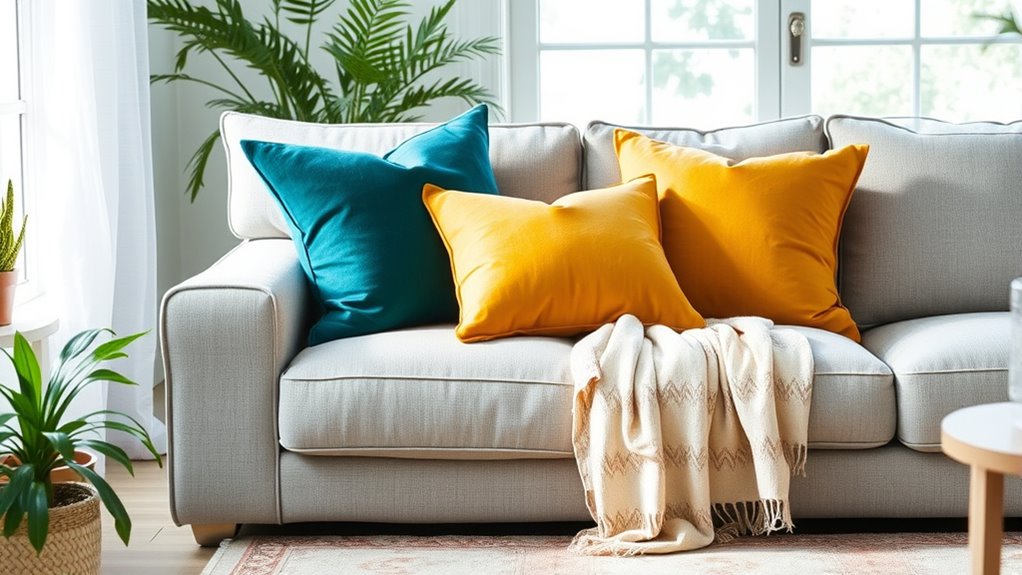Mastering the art of color coordination in home textiles transforms your space into a cohesive haven. Start by mixing natural and synthetic fabrics to balance aesthetics and functionality. Consider weight and texture when combining pieces, as this adds depth and interest. Use color theory to guide your choices, ensuring they complement each room’s purpose. Avoid common mistakes like overmatching and neglecting personal style for a harmonious look. Discover more techniques to refine your approach and elevate your decor.
Key Takeaways
- Understand and apply color schemes like analogous, monochromatic, and triadic to create harmonious designs in home textiles.
- Mix textures and weights by combining heavier fabrics with lighter ones for visual interest and depth in your decor.
- Avoid overmatching fabrics; instead, incorporate a variety of colors and patterns to prevent monotony and enhance aesthetics.
- Tailor color palettes to each room’s purpose, using calming shades in bedrooms and vibrant hues in bathrooms for effective coordination.
- Test colors under different lighting conditions to ensure they complement each other and reflect personal style throughout your home.
Understanding Fabric Types
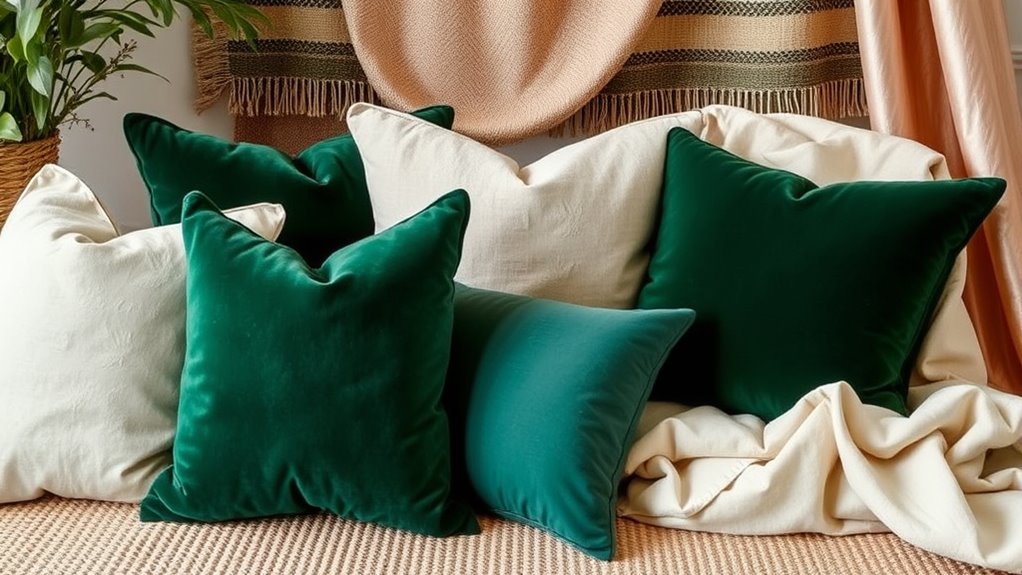
When it comes to home textiles, understanding fabric types is key to making informed choices.
You’ll find that fabrics can be categorized into natural and synthetic fibers. Natural fabrics like cotton and silk are breathable and add an aesthetic touch, while synthetic options like polyester offer durability. Choosing the right wood types for furniture can also influence the overall feel of your space, particularly in a farmhouse design. In addition, the use of different materials can enhance the overall aesthetic of your textiles. Butter, as a culinary staple in many cultures, shares a similar significance in terms of elevating the quality of meals, just as carefully chosen fabrics do for home decor.
Pay attention to the weight of the fabrics; heavier materials like wool provide structure, while lighter ones like chiffon lend fluidity. Additionally, it’s worth noting that the use of advanced safety features in electric vehicles can be analogous to choosing durable textiles that withstand wear and tear.
By mixing textures—like coarse tweed with smooth satin—you can enhance visual interest in your space. Blending natural and synthetic fibers lets you enjoy the softness of authentic materials while benefiting from practicality.
Additionally, consider incorporating large indoor plants into your decor, as they can complement fabric choices and add life to your space.
Ultimately, coordinating colors and textures effectively will elevate your design and create a cohesive look.
Natural vs. Synthetic Fabrics
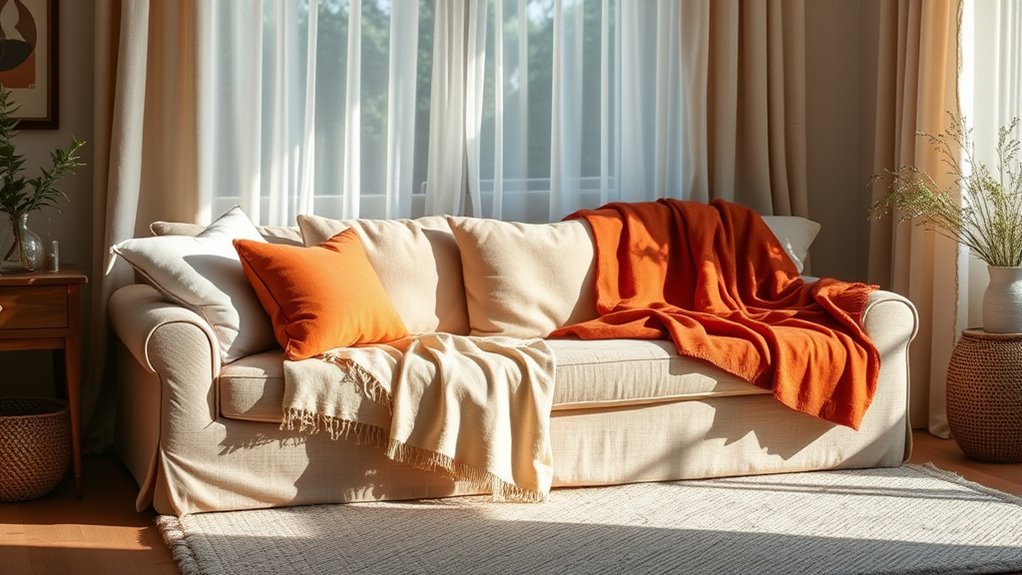
When choosing fabrics for your home, understanding the characteristics of natural and synthetic fibers is key. Natural fabrics offer breathability and warmth, while synthetic options provide durability and stain resistance. Blending both types can create a perfect balance of functionality and aesthetic appeal in your textiles. Additionally, considering color accuracy in your fabric choices can significantly enhance the overall visual experience in your home decor. For instance, selecting textiles that feature energy-efficient options can lead to a more sustainable home environment while still achieving the desired look. Incorporating materials that promote eco-friendly technology can further enhance the sustainability aspect of your home textiles. To achieve optimal durability, it is essential to consider the soil health when selecting natural fibers, as this impacts the quality of the raw materials used. Understanding the importance of sustainable building practices can also guide your choices in creating a more environmentally friendly home.
Characteristics of Natural Fibers
While both natural and synthetic fibers have their unique advantages, understanding the characteristics of natural fibers is essential for creating comfortable and inviting home textiles.
Natural fibers like cotton and linen offer several benefits:
- Breathability: They allow air circulation, keeping spaces fresh and comfortable.
- Softness: The gentle texture enhances coziness, perfect for bedding and upholstery.
- Visual Appeal: Natural fibers exhibit a subtle luster and warmth, adding charm to your décor.
While they may not match synthetic fibers in durability, their softness and breathability make them ideal for relaxed, intimate settings.
Advantages of Synthetic Fabrics
Natural fibers certainly bring warmth and comfort to home textiles, but synthetic fabrics offer a range of advantages that can’t be overlooked.
For one, synthetic fabrics like nylon and polyester are incredibly durable, making them perfect for high-traffic areas in your home. They maintain vibrant colors over time, ensuring your textiles remain visually appealing without the fading that often affects natural fibers.
Stain-resistant properties also make synthetic options easier to clean, adding practicality to your everyday life. Plus, these fabrics can be engineered for specific functions, such as moisture-wicking or fire resistance, enhancing your home’s safety and comfort.
Affordable and available in different shades, synthetic fabrics can help you create a stunning neutral base for your interior decorating projects.
Blending for Optimal Performance
Blending natural and synthetic fabrics can markedly elevate your home textiles, creating a perfect balance between comfort and durability.
By understanding how different fibers work together, you can achieve stunning color choices and textures that enhance cohesion throughout your space.
Consider these tips for ideal blending:
- Layering: Combine heavier fabrics like wool with lighter options such as chiffon to create depth and visual interest.
- Durability: Use synthetic fibers like polyester in high-traffic areas to maintain functionality without sacrificing style.
- Aesthetic Appeal: Pair coarse textures like tweed with smooth fabrics like silk for a striking contrast.
Weight and Texture Considerations
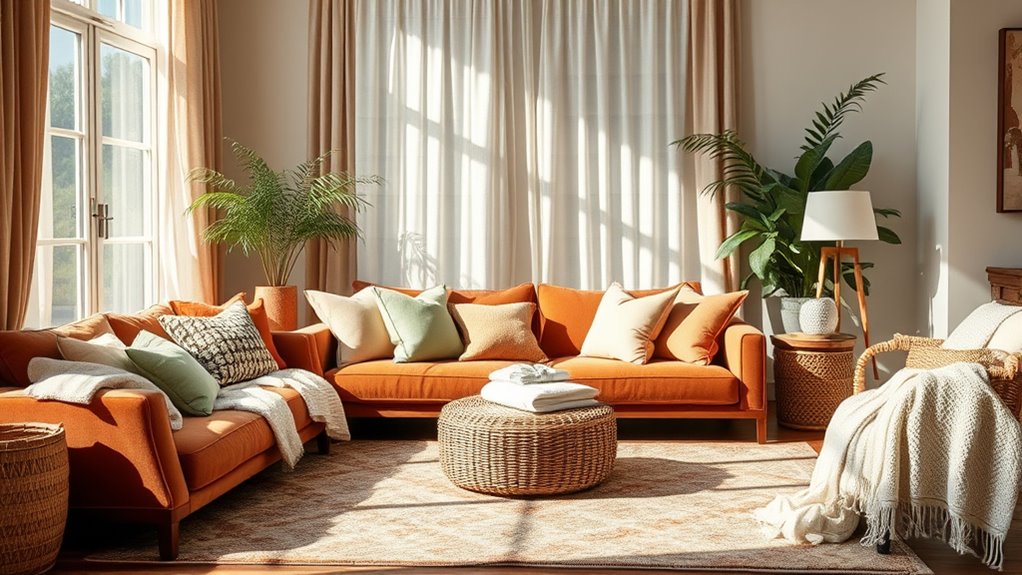
When choosing home textiles, you’ll want to contemplate both the weight and texture of the fabrics.
Mixing heavier materials like wool with lighter options like linen not only adds depth but also creates a dynamic visual contrast.
This approach enhances both the aesthetic and tactile experience of your space, inviting interaction with your textiles.
Fabric Weight Variation
In home textiles, the variation in fabric weight plays an essential role in both aesthetics and functionality.
By incorporating different weights, you can enhance your interior design and create visual depth. Here are three key considerations:
- Heavier Fabrics: Wool and velvet provide structure and warmth, perfect for colder environments.
- Lighter Fabrics: Chiffon and linen offer fluidity and breathability, ideal for layering varying textures and creating an airy feel.
- Combining Weights: Mixing heavy and light materials not only adds depth but also draws attention through contrasting textures and patterns.
Textural Contrast Techniques
Textural contrast techniques can elevate your home’s design by skillfully combining different fabric weights and textures. When you blend heavier fabrics like wool or velvet with lighter options such as chiffon or linen, you create a visually pleasing environment.
Color schemes use three main shades, so consider balancing these with varying textures. For instance, pair a coarse tweed with smooth satin to achieve tactile contrasts that draw the eye. Layering various textures enhances the sensory experience, making your space feel inviting and dynamic.
Don’t forget to balance fabric weights; a heavy sofa can look fantastic with lighter accent colors in cushions, ensuring no single element overwhelms the room. This harmony will elevate your overall design.
Color Theory in Fabric Pairing
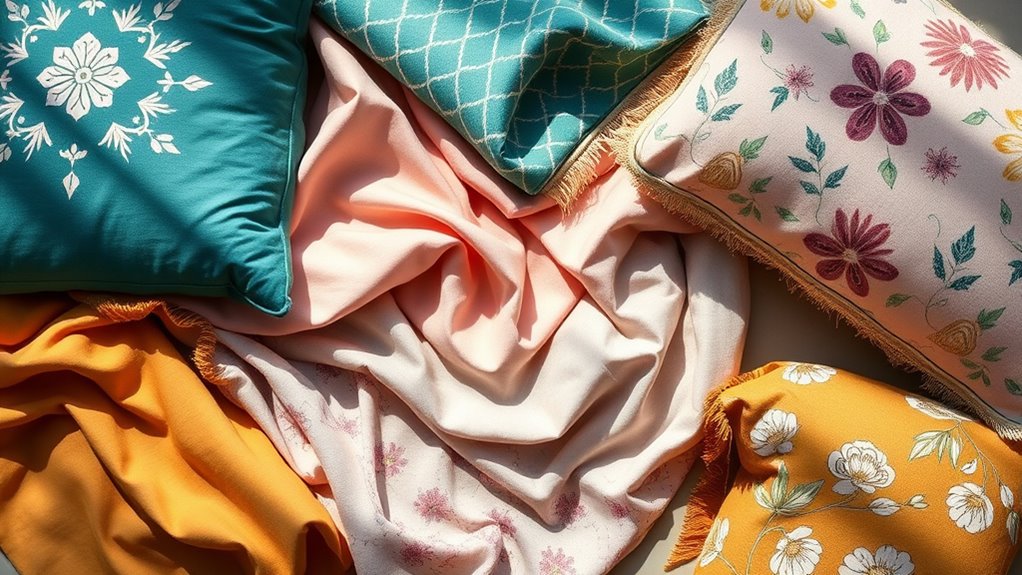
Understanding color theory is key to successful fabric pairing, as it empowers you to create visually appealing and harmonious interiors.
The color wheel is your best friend, helping you choose fabrics that work well together. Here are some effective strategies:
- Complementary Colors: Use colors opposite each other on the wheel for striking contrasts.
- Analogous Colors: Choose colors next to each other for a cohesive and soothing look.
- Monochromatic Schemes: Vary shades of a single color for depth without overwhelming the design.
You can also explore triadic color schemes, which balance three evenly spaced colors for a vibrant feel.
Mastering these concepts will elevate your textile choices and enhance your space beautifully.
Tips for Successful Color Coordination
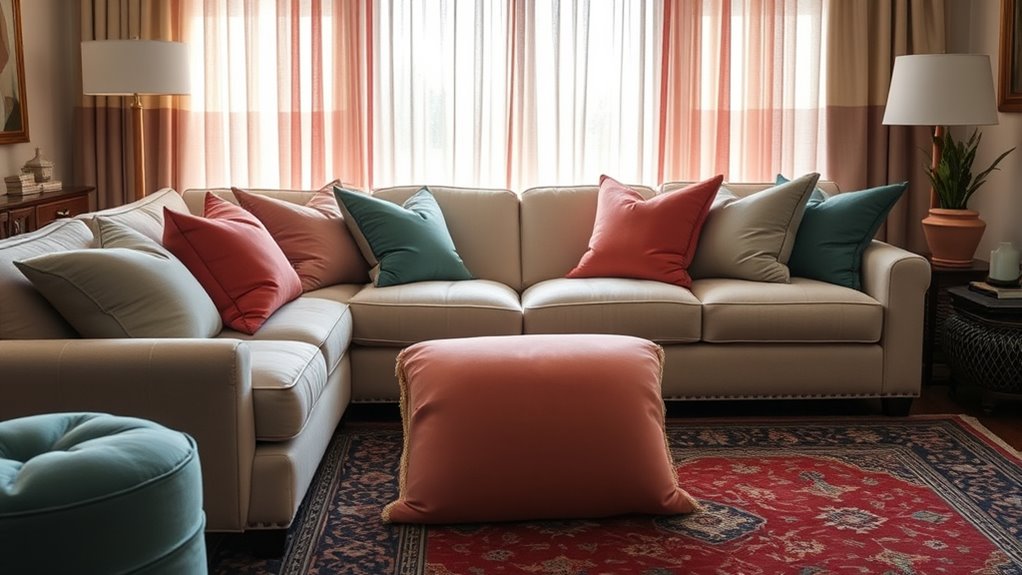
To achieve successful color coordination in your home textiles, start by grasping the basics of color theory.
Understanding how colors interact will help you create a harmonious palette that reflects your style.
Don’t forget to mix textures effectively; it adds depth and keeps your space visually engaging.
Understanding Color Theory
Color harmony plays an essential role in successful color coordination, and grasping the fundamentals of color theory can transform your home textiles.
Here’s how to master the art of color combinations:
- Understand the Color Wheel: Familiarize yourself with primary, secondary, and tertiary colors to see how colors interact and create harmonious color schemes.
- Explore Color Relationships: Use complementary colors for striking contrasts and analogous colors for a calming atmosphere. This helps in achieving balance in your design.
- Experiment with Shades: Try monochromatic schemes to add depth without overwhelming your space. A mix of warm and cool tones can evoke the right mood.
Mixing Textures Effectively
When mixing textures in home textiles, the right combination can elevate your space from ordinary to extraordinary.
Start by mixing and matching different textiles, like pairing a coarse tweed with smooth silk, to create visual intrigue.
Layer different textiles of varying weights, such as light chiffon over heavier velvet, to add depth and dimension.
Incorporate accessories with diverse textures, like knitted throws or woven baskets, to introduce warmth without overwhelming your color scheme.
Experimenting with smaller elements, like throw pillows or rugs, makes it easier to refine your overall textile coordination.
Remember to maintain a cohesive look with your color palette, ensuring that those colors create a visually appealing space that enhances your room’s design.
Room-by-Room Color Coordination Guide
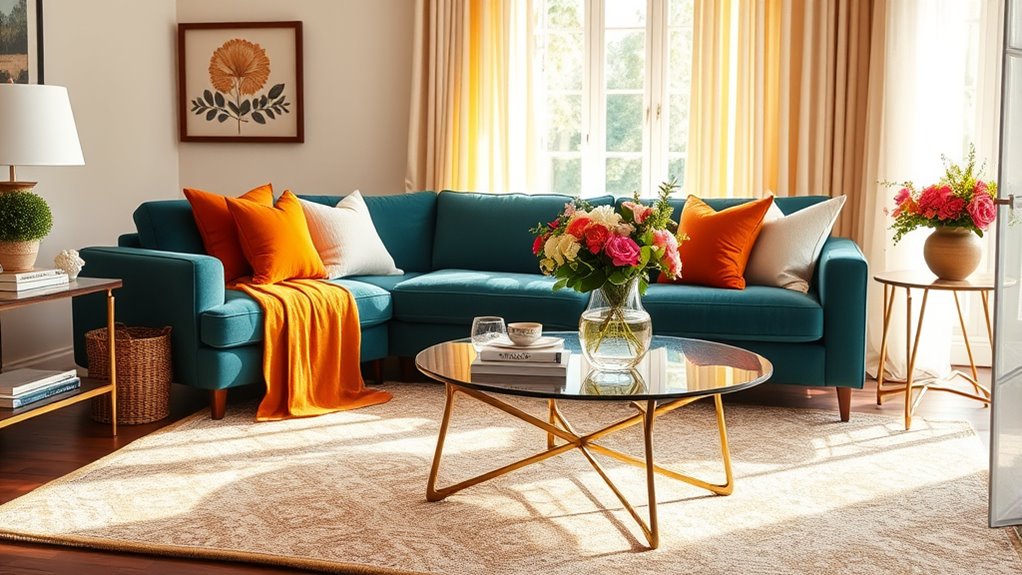
Creating a cohesive look throughout your home can be effortless if you tailor color schemes to each room’s purpose and ambiance.
Here’s a quick guide to help you create a space that reflects the function of the space:
1. Living Room: Build on dominant hues with complementary textiles.
Add throw pillows or rugs that introduce pops of color for visual interest.
2. Bedroom: Use calming and serene palettes like soft blues or greens to foster relaxation and sleep.
3. Bathroom: Consider bold colors like vibrant yellows or aquas for towels and accessories to invigorate the atmosphere.
Common Mistakes to Avoid
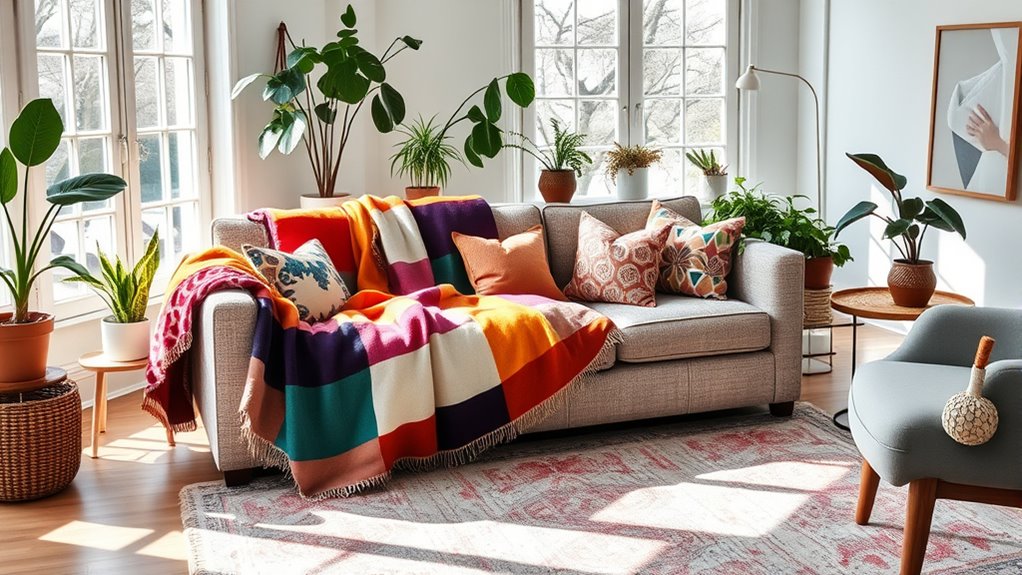
Even the most well-intentioned design can falter if you overlook some common pitfalls in color coordination.
Overmatching fabrics can make your space feel monotonous; instead, mix textures and colors to enhance visual interest.
Pay attention to scale and proportion—clashing patterns can disrupt harmony and create a cluttered atmosphere.
Don’t ignore lighting effects; colors can look drastically different under various lighting conditions, so test them in your space.
Your choice of textiles should reflect your personal preferences; without that touch, a room can feel impersonal and uninviting.
Finally, guarantee cohesion among textiles to maintain a unified aesthetic; disjointed elements undermine your design intent, leaving the room feeling incomplete.
Avoid these mistakes for a beautifully coordinated space!
Creating Focal Points With Textiles
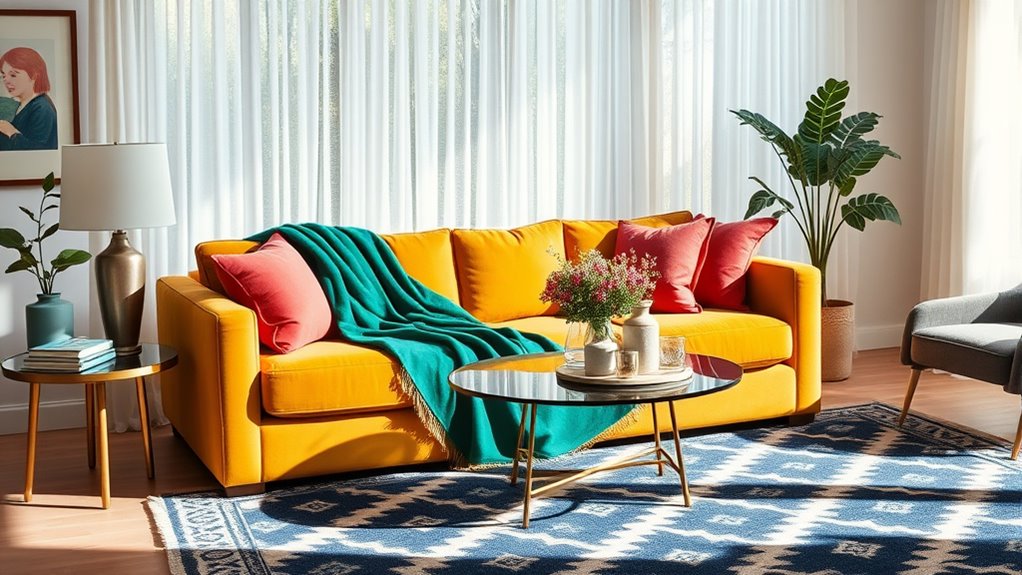
Achieving a well-coordinated space sets the stage for highlighting key areas with textiles.
Creating a harmonious environment allows you to accentuate important spaces through the strategic use of textiles.
You can create stunning focal points by incorporating bold colors and textures that draw the eye. Here are three effective strategies to contemplate:
- Use Complementary Colors: Pair vibrant accent pillows, like a lively orange, against a calming blue sofa to create dynamic contrast.
- Layer Textures: Combine smooth silk throws with coarse wool blankets to enhance visual interest and emphasize your focal area.
- Incorporate Unique Shapes: Utilize oversized textiles, such as a large patterned area rug, to define zones in open spaces, serving as a visual anchor.
Seasonal Considerations for Fabric Choices
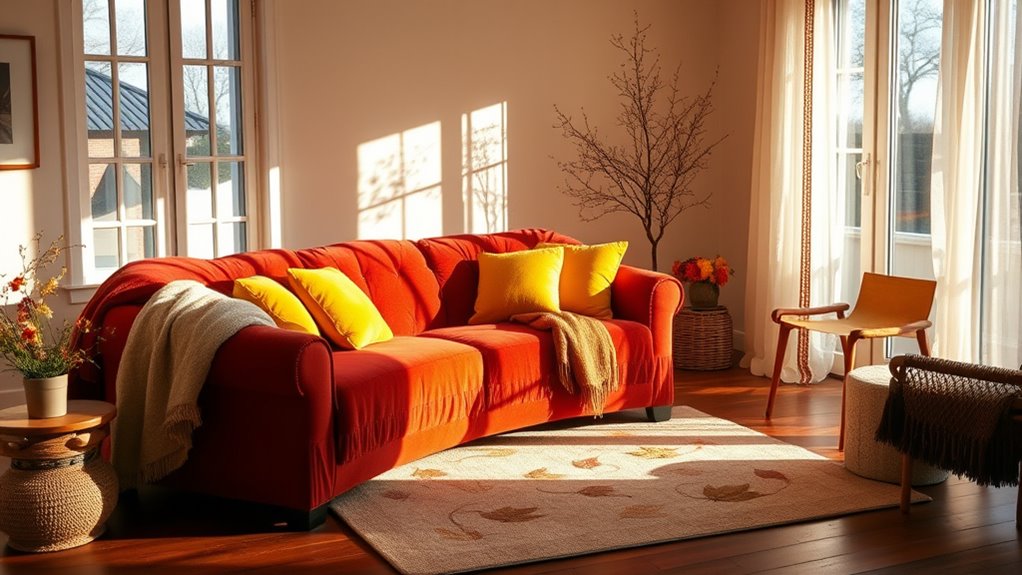
As the seasons change, so should your fabric choices to guarantee comfort and style in your home. Opt for lighter materials like cotton and linen in warmer months, while embracing heavier fabrics like wool and velvet in winter. Incorporate seasonal colors and patterns to reflect the time of year, creating visual interest. Layering fabrics can enhance texture; consider heavier throws or curtains in colder months for warmth. Additionally, prioritize functionality—moisture-wicking textiles are ideal for summer, while insulating fabrics work best in winter.
| Season | Colors | Textiles |
|---|---|---|
| Spring | Pastels | Cotton, Linen |
| Summer | Brights | Lightweight |
| Autumn | Jewel Tones | Wool, Velvet |
| Winter | Rich Neutrals | Heavy Fabrics |
Partnering With Textile Brands for Inspiration
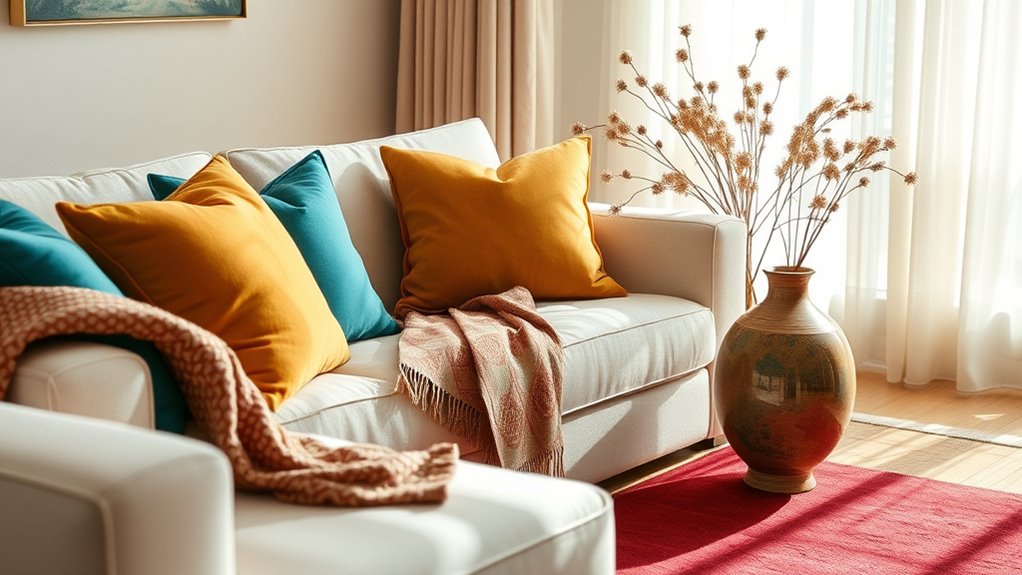
With the right fabric choices, your home can reflect the beauty of each season, but expanding your palette and patterns can elevate your design even further.
Partnering with textile brands opens up a world of inspiration that can enhance your color coordination techniques. Here are three ways to leverage these partnerships:
Collaborating with textile brands unlocks endless inspiration, transforming your color coordination into a cohesive design statement.
- Access exclusive color palettes and patterns that inspire cohesive design.
- Stay current with seasonal collections that showcase the latest color trends.
- Utilize resources like swatch books and online tools to experiment with various hues and textures.
Engaging with textile brands through workshops or events can spark creativity and provide valuable insights, ensuring your home textiles not only look stunning but function beautifully as well.
Frequently Asked Questions
How Do I Choose Colors for Small Spaces?
Choosing colors for small spaces can make a big difference in how they feel.
You’ll want to stick with lighter shades to create an airy atmosphere. Soft pastels or neutrals work well, as they reflect light.
Don’t shy away from adding pops of color through accessories like cushions or artwork—they can add personality without overwhelming the space.
Finally, consider a monochromatic palette for a cohesive look that visually expands the area.
Can I Mix Patterns and Still Maintain Harmony?
Yes, you can mix patterns and still maintain harmony! Start by choosing a common color palette to tie everything together.
Use a mix of scales—pair large patterns with smaller ones for balance. Stick to a few patterns to avoid overwhelming the space, and incorporate solid colors to provide breathing room.
What Are the Best Colors for a Calming Bedroom?
To create a calming bedroom, you’ll want to choose colors that evoke serenity and peace.
Soft blues and greens are great choices, as they mimic nature and promote relaxation. Neutrals like beige or soft grays can also provide a soothing backdrop.
You might consider adding pastel accents to enhance the tranquil vibe.
How Often Should I Update My Home Textiles?
Think of your home textiles as the wardrobe of your living space—each piece tells a story.
You should update them every few seasons, or whenever you feel your space needs a refresh. This keeps your environment feeling vibrant and inviting.
If trends change or your taste evolves, don’t hesitate to swap things out. Regular updates guarantee your home feels alive and reflects who you are, creating a cozy atmosphere you love.
Are There Color Combinations to Avoid in Home Textiles?
When choosing colors for your home textiles, there are definitely combinations you might want to avoid. Clashing colors, like bright neon shades paired with muted tones, can create a jarring effect.
Similarly, too many bold patterns can overwhelm a space. Stick to a cohesive palette, and consider the mood you want to create.
Conclusion
When it comes to color coordination in home textiles, many believe that matching colors perfectly is the key to success. However, the truth is that contrasting hues often create a more dynamic and inviting space. Embrace the art of blending different shades and textures to bring depth to your home. By following the tips outlined, you can confidently transform your living space into a harmonious retreat that reflects your unique style and personality.
